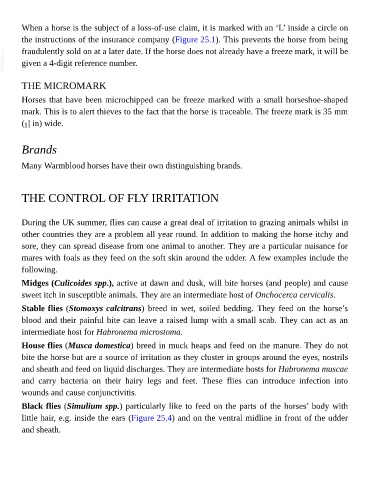Page 1120 - The Veterinary Care of the Horse
P. 1120
When a horse is the subject of a loss-of-use claim, it is marked with an ‘L’ inside a circle on
the instructions of the insurance company (Figure 25.1). This prevents the horse from being
VetBooks.ir fraudulently sold on at a later date. If the horse does not already have a freeze mark, it will be
given a 4-digit reference number.
THE MICROMARK
Horses that have been microchipped can be freeze marked with a small horseshoe-shaped
mark. This is to alert thieves to the fact that the horse is traceable. The freeze mark is 35 mm
( in) wide.
Brands
Many Warmblood horses have their own distinguishing brands.
THE CONTROL OF FLY IRRITATION
During the UK summer, flies can cause a great deal of irritation to grazing animals whilst in
other countries they are a problem all year round. In addition to making the horse itchy and
sore, they can spread disease from one animal to another. They are a particular nuisance for
mares with foals as they feed on the soft skin around the udder. A few examples include the
following.
Midges (Culicoides spp.), active at dawn and dusk, will bite horses (and people) and cause
sweet itch in susceptible animals. They are an intermediate host of Onchocerca cervicalis.
Stable flies (Stomoxys calcitrans) breed in wet, soiled bedding. They feed on the horse’s
blood and their painful bite can leave a raised lump with a small scab. They can act as an
intermediate host for Habronema microstoma.
House flies (Musca domestica) breed in muck heaps and feed on the manure. They do not
bite the horse but are a source of irritation as they cluster in groups around the eyes, nostrils
and sheath and feed on liquid discharges. They are intermediate hosts for Habronema muscae
and carry bacteria on their hairy legs and feet. These flies can introduce infection into
wounds and cause conjunctivitis.
Black flies (Simulium spp.) particularly like to feed on the parts of the horses’ body with
little hair, e.g. inside the ears (Figure 25.4) and on the ventral midline in front of the udder
and sheath.

